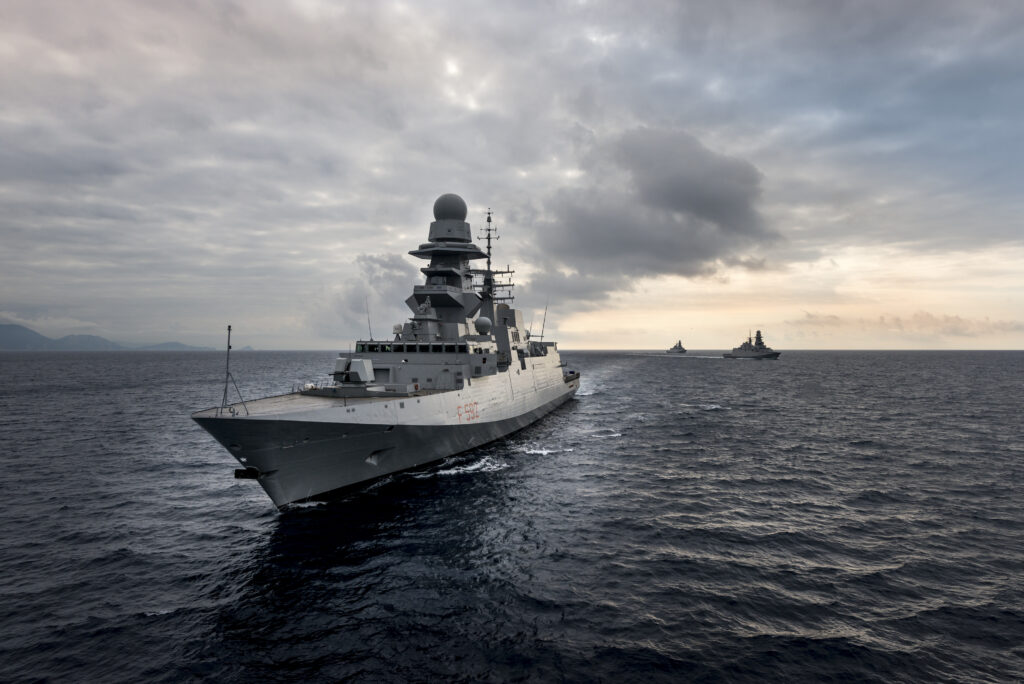
The Navy chose a version of the Italian Bergamini-class ship for the parent design of its new frigate.
WASHINGTON: The Navy’s decision to tap Wisconsin’s Fincantieri Marinette Marine to build the first 10 of a new class of guided missile frigates last month could be the first real step toward a faster, more numerous and more lethal fleet.
In some circles, the award is also being seen as a direct challenge to the rapidly expanding Chinese navy.
“It was a great day for Wisconsin, and a bad day for the PLA Navy” Rep. Mike Gallagher said in a recent interview.
Gallagher, a Wisconsin lawmaker, China hawk and member of the House Armed Services Committee, sees the frigate as a cornerstone piece for growing the Navy while not blowing open what is likely to be a constrained budget in the coming years.
Plans call for the frigate to be a small, multi-mission ship bearing the Aegis combat system, 32 vertical launch tubes and the state-of-the-art SPY-6 radar system. The ship will be smaller than the Arleigh Burke destroyer, the Navy’s current workhorse, but it will also be outfitted with the ability to generate much more power for advanced electronic warfare systems, along with anti-submarine warfare gear.
Smaller and cheaper are some of the ship’s biggest selling points for a Navy leadership team eager to start working toward a 355-plus fleet while they strive to keep budgets in check. All of these attributes should allow these frigates to show American presence in the thousands of islands and atolls of the Pacific coveted by China.
Where the frigate fits into the Navy’s overall plan is unclear, however, as the long-awaited Integrated Force Structure Assessment, originally due in January, has been held up by Defense Secretary Mark Esper, who wants his team to take it’s own crack at developing the fleet of the future.
“If you just look at the geography of Indo-Pacom, these ships can go a lot of places that destroyers can’t go,” Gallagher said. “So my hope is that when and if we ever see the Integrated Force Structure Assessment, it will have a robust role for not just frigates, but unmanned ships, and it will align nicely with a lot of what the Marine Corps Commandant is talking about in terms of capitalizing on the overdue death of the INF Treaty, and fielding intermediate range fires.” All of this would “complicate life for the PLA Navy,” he added.
Gallagher said he supports growing the Navy beyond the current 355-ship goal, recognizing that to get there many of the new ships will have to be cheaper, smaller and unmanned. “Much of that growth is going to have to come from small surface combatants and smaller ships, things below the level of carriers and destroyers.”
Also of interest to the representative from Wisconsin is Fincantieri’s win assuring more work for the company’s Wisconsin shipyard, which is building the last mono-hull Littoral Combat Ships, along with a version of the LCS for Saudi Arabia. The frigate win assures Fincantieri a place in the top tier of US shipbuilders, with both the LCS and now at least 10 frigates in the fleet.
The company offered its FREMM design, currently in use by the Italian and French navies.
But with winners, come losers. Huntington Ingalls Industries was also in the running, but with about $45 billion worth of work on the books already, the nation’s aircraft carrier builder will weather the loss.
“We’re obviously very disappointed in the way it came out, but we’ll get a debrief from the Navy on what happened and how it could have gone better, and we’ll go forward from there,” Mike Petters, the company’s chief executive, told analysts during a conference call last week.
The loss is potentially more damaging for Austal USA, which has already delivered 11 Independence-variant Littoral Combat Ships with eight more on the books by time the contract runs its course in 2024. The company is also building three more Expeditionary Fast Transports in the coming years.
“Despite our extreme disappointment over this outcome, we have a portfolio of other opportunities that we continue to pursue in addition to our backlog of EPF and LCS work,” including unmanned surface vessels, Austal USA President Craig Perciavalle said.
Gallagher said he sees the Navy’s decision to recompete the frigate award after the first 10 ships as good for the program, and potentially, the industrial base. For the shipyard in his state, there’s no question that after the LCS work ends, “there would have been some very difficult decisions, and so this effectively means a couple decades of work for the shipyard and a pretty dramatic expansion given just what’s going to be required to build the ship.”
Some analysts have suggested the Navy needs as many as 50 or more frigates, and Gallagher said “I think you can make an argument for building far more frigates than the 20 that are planned.” But keeping as many shipyards open as possible is also important for the overall health of the shipbuilding industrial base, and the congressman said eventually other yards could also work on the program.
“There’s a legitimate argument to be made about the fact that we need to keep all seven shipyards alive and not have further consolidation,” Gallagher said. “If we have smart Navy and DoD leadership, I think there’s room for two shipyards, that’d be healthy for the industrial base.”
Multi-ship amphib buy could net $900M in savings, say Navy, Marine Corps officials
Lawmakers gave the Navy authorities to ink a multi-ship amphib deal years ago, but the service has not utilized that power yet.


























